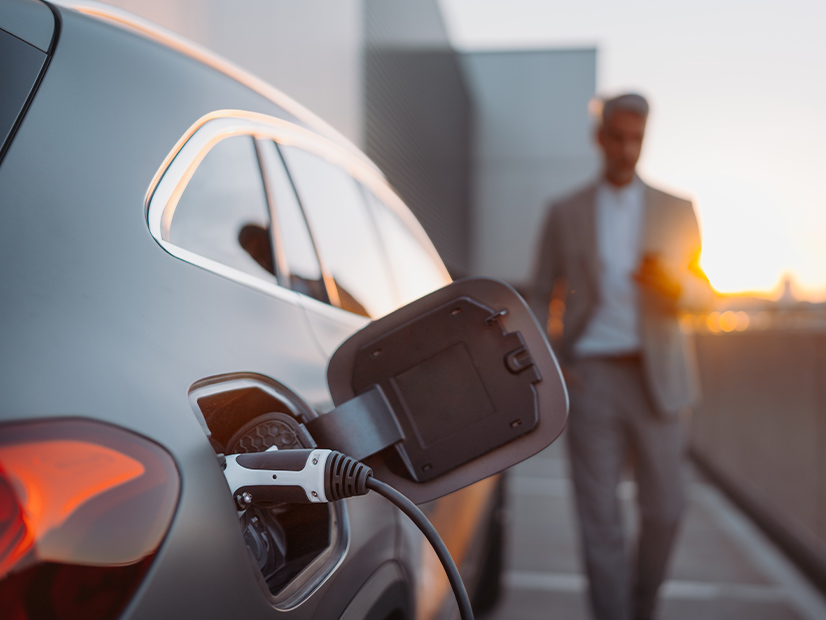The most pressing questions about the final rules on the Inflation Reduction Act’s electric vehicle (EV) tax credits issued May 3 should not be about their nitpicking complexity or whether they comply with the letter of the law in every single detail, but if and how they could affect EV sales and market growth in the United States.
The Internal Revenue Service issued its final rules on which vehicles are eligible for the $7,500 tax credit for new EVs — including the law’s much-debated domestic content provisions — while the Department of Energy issued its final rule on “foreign entities of concern” (FEOCs), another key component of eligibility requirements.
The IRS has been working on the rules since December of 2022, when it issued its first policy paper and notice of intent for proposed rulemaking outlining its approach to the EV tax credit provisions — including the basic eligibility requirements originally drafted by Sen. Joe Manchin (D-W.Va.).
The key change in the final rules is a two-year phase-in for certain elements of the domestic content requirements, allowing more time for the U.S. to stand up its own supply chains for the critical minerals and other components used in EV batteries, which in turn could increase the number of EV models qualifying for the credit.
Beginning Jan. 1, 2027, automakers will be required to perform rigorous upfront tracking and certification of domestic content in their supply chains, but until then, will be able to continue using a less rigorous certification process established in the proposed rules.
The final rule also adds graphite used in battery anode materials to a short list of other critical materials that are used in EV batteries in such small amounts that they are classified, at present, as “impracticable to trace” — and therefore exempt from the domestic content requirements at least until Jan. 1, 2027.
Manchin immediately blasted the Biden administration for creating “loopholes” in the law, which could allow China to continue dominating the EV battery market rather than supporting the domestic supply chains, which he intended the IRA to create.
“The entire point of the Inflation Reduction Act was to provide American businesses the incentives they need to bring our energy and manufacturing supply chains back to the U.S., reduce our dependence on foreign adversaries and create good-paying American jobs,” he said in an email statement. “Instead of embracing those opportunities to benefit our country, the administration is so desperate for Chinese EV components that they are blatantly breaking the law by implementing a bill that they did not pass and ignoring what Congress agreed upon at the expense of American workers and taxpayers.”
But John Bozzella, president and CEO of the Alliance for Automotive Innovation (AAI), an industry advocacy group, framed the final rules as “good sense for investment, job creation and consumer EV adoption … [and] providing some temporary flexibility in terms of where the critical minerals in EV batteries can be sourced.
“The EV transition requires nothing short of a complete transformation of the U.S. industrial base. That’s a monumental task that won’t ― and can’t ― happen overnight,” Bozzella said in a statement on the AAI website.
“Imagine an EV that complied with all IRA eligibility requirements but is kicked out of the program because of a trace amount of a critical mineral from an FEOC,” he said. “That makes no sense — especially when you consider the massive investments automakers and suppliers are making in domestic EV manufacturing.”
The Basics
Despite criticism from Manchin and other stakeholders, the IRS final rule maintains the basic eligibility requirements laid out in the law and in the agency’s previous iterations of different provisions of the rule issued in April, October and December of 2023.
To qualify for the tax credits, the final assembly of an EV must occur in North America, the retail price must not exceed $55,000 for a sedan or $80,000 for an SUV or light-duty pickup, and the weight must not exceed 14,000 pounds. Prospective buyers cannot earn more than $150,000 for those filing their taxes as individuals, $225,000 for single heads of house and $300,000 for couples filing jointly.
Whether any one vehicle qualifies for a partial $3,750 credit or full $7,500 credit depends on its domestic content. For the full credit, a vehicle must meet gradually increasing requirements for both critical mineral content in its battery and other battery components. Meeting only one of the domestic content requirements qualifies a vehicle for the partial credit.
For example, the mandated percentage of the value of critical minerals in an EV battery that are domestically sourced and processed began at 40% in 2023, is 50% this year and will increase yearly by 10% until it reaches 80% in 2027 and beyond.
The FEOC rules are similarly straightforward: Beginning this year, any EV with critical minerals or other battery components either sourced or processed by a “covered nation” ― China, Russia, North Korea or Iran ― or other foreign entity of concern will not be eligible for the tax credit.
The rule also spells out a list of conditions under which a company can be classified as an FEOC, such as whether it is in a covered nation or whether a covered nation has a 25% controlling interest, via seats on a board or equity interest.
But the exact calculus between these eligibility requirements, the time frames for domestic supply chain buildout and auto industry confidence in consumer demand remains uncertain.
The AAI estimates that electric vehicle and battery manufacturers have invested $125 billion to stand up U.S. supply chains since 2017, while the administration pegs the figure at $173 billion in new investments announced since Biden was elected.
According to DOE, average monthly sales of EVs doubled from about 50,000 per month in 2021 to more than 100,000 in 2023. Total EV sales in 2023 topped a record-breaking 1.6 million.
Bumps in the Road
But sales have not increased as fast as automakers expected, and U.S. market leaders, including GM and Ford, have scaled back their investments and time frames for ramping up EV production, shifting instead toward a focus on plug-in hybrids.
According to Kelley Blue Book, 268,909 EVs were sold in the U.S. in the first quarter of 2024, a modest year-over-year increase of 2.6% compared to the 46.4% jump between the first quarters of 2022 and 2023.
But Kelley’s analysis suggests that “the slow growth may be a sign that EVs are almost mainstream cars in parts of the country. Segment growth typically slows as volume increases.
“Consumers follow a predictable curve as they adopt new technologies. There’s almost always an initial surge as early adopters excitedly jump in. Then sales growth slows as more skeptical consumers take a look at the technology and have to be convinced.”
The role of EV tax credits in consumer decisions on going electric also may vary. Kelley’s analysis points to price as a major factor, and the IRS rule allows for direct pay of the tax credit at point of sale for eligible vehicles, which could make EVs more affordable and attractive.
Tax credits have been paid at point of sale for more than 100,000 vehicles so far this year, according to the Treasury Department.
AAI estimates that the U.S. EV market now offers consumers about 114 models, but only 22 are eligible for a partial or full tax credit: nine plug-in hybrids and 13 full electric models.
The catch here is that automakers in most cases are entering the EV market with more expensive SUV and light pickup models. DOE’s list of EVs and plug-in hybrids eligible for IRA tax credits in 2024 include only two classified as sedans: the Nissan Leaf and Tesla’s Model 3.
One of the more affordable models on the market, Chevrolet’s popular Bolt, was discontinued in December of 2023.
The slow rollout of a national network of public chargers ― both Level 2s and DC fast chargers ― also has frustrated consumer and industry expectations. The Infrastructure Investment and Jobs Act’s $5 billion National Electric Vehicle Infrastructure (NEVI) program has, to date, installed only eight of the 500,000 fast chargers President Joe Biden wants on the nation’s highways by 2030.
On April 23, Vermont’s first NEVI charger ― with four ports, located in the town of Bradford ― joins the handful of others now online in Hawaii, Maine, New York, Ohio and Pennsylvania.

